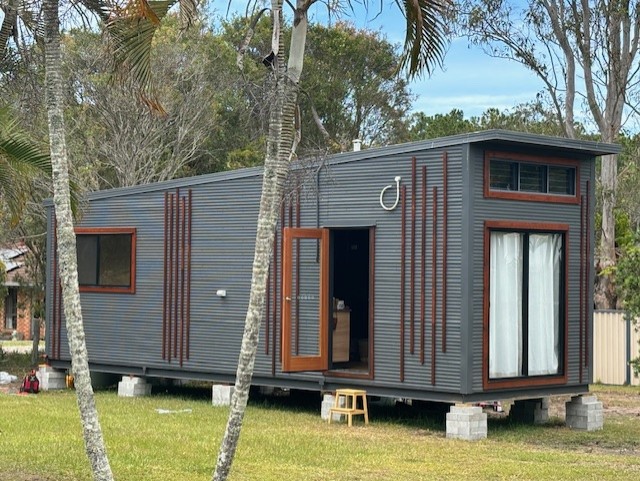
FAQ’s
Read more about our FAQ’s here. Tiny Homes often feature innovative design solutions and multifunctional furniture to make the most of limited space. They offer a minimalist lifestyle, focusing on simplicity, sustainability, and financial freedom.
What is a Tiny Home?
The classification of a tiny house is a small house that typically has a floor plan with an area of 180m2 or less.
What is the Tiny House Movement?
The Tiny House Movement is the social movement that advocates living simply in small homes. The reasoning behind people wanting to downsize and move into a tiny house is normally one of three reasons:
- To save money
- To simplify their life
- To help the environment.
Another reasoning behind why people are going tiny is the affordability issue with housing. Living in a Tiny Home gives the ability and freedom for some to become homeowners in a time where becoming a homeowner is out of reach because of the cost of buying a home in today’s economy.
Do I need council approval to have a demountable building on my land?
We recommend that you contact a town planner in your area and let them know you’re interested in possibly installing a secondary dwelling or Granny Flat on to your property. They will be able to help you out by letting you know whether it would be possible, as well what sized building would be possible to have on your property. They can also help you with submitting a DA with your council to get one of our buildings approved for your property.
How big are the demountable buildings?
Our Building sizes, along with their m2 size are listed below:
- 6m long x 3m wide (Total area = 18m2 )
- 6m long x 3.4m wide (Total area = 20.4m2 )
- 8m long x 3m wide (Total area = 24m2 )
- 8m long x 3.4m wide (Total area = 27.2m2 )
- 6m long x 3m wide (Total area = 28.8m2 )
- 6m long x 3.4m wide (Total area = 32.64m2 )
- 12m long x 3m wide (Total area = 36m2 )
- 12m long x 3.4m wide (Total area = 40.8m2 )
What is included in the Base Pricing?
You can find a full list of everything that we include in our base pricing as standard on our Pricing & Inclusions page.
On this page, we also include a price list for optional extras and upgrades that can be added to any building at an extra cost.
We are one of the only Portable Building companies that are transparent and advertise their pricing on their website. You will be able to have an idea of how much $$$ you will be up for before you even contact us to make a design appointment or to enquire for more information.
What’s not included in the pricing?
- Transport cost – We don’t own trucks and don’t 100% know the cost of transport. For transport quotes, it’s best to call some trucking companies to get a quote, as we don’t know these costs. Transport cost is calculated on a $ price per KM basis, so pricing will differ from customer to customer, depending on the location of their land and distance from our property. It would be best to get a firm quote from a transport company. We can give contact details for a couple of trucking companies we usually recommend to our customers, should you be interested in placing an order with us.
- Installation – We don’t do the installation. If you are local to the Brisbane, Gold Coast or Sunshine Coast Regions, we have a builder that we refer our customers to if they are needing someone to install the building, as well as organise the council approvals and certifications.
Otherwise, if you are not located in these regions, you will need to chat with a someone local to your area, like a Builder, house stumper or carpenter, as the building needs to be stumped. A QBCC registered builder in your area will be able to do this for you and coordinate the installation and the other trades needed regarding the installation of the building on your property, as you will require a plumber to connect water and sewerage, as well as an electrician to connect mains power to the power box of the building. - Hot Water System – We don’t include a hot water system in our inclusions for a few reasons:
Reason 1… Nine times out of ten, the hot water system would take our building over the maximum width (3490mm wide) allowed for oversized transportation without a pilot vehicle. Pilot vehicles can add a substantial cost to your transportation, especially if the building is to be delivered a fair distance from our location. - Reason 2… There are numerous types of systems on the market (electric tanks, gas instantaneous, solar) and every person has their own preference for what system they want to use. We provide an external double power point in your preferred hot water system location that is wired on its own fuse, so that you can have your plumber install the system of your preference when they connect all your plumbing tails together to the water and sewerage supply.
Does the building come with any certifications, plans, etc…?
Our buildings are brand-new and manufactured to order. We will provide the following forms and certificates with all our buildings upon completion:
- Form 15 for Skids and Base
- Form 15 and engineering for the Steel Framing
- Form 15 for Windows and Sliding Door
- Form 15 for Internal Waterproofing
- Form 18A for Shower Plumbing Rough-in
- Form 15 for wall & ceiling Insulation
- Form 15 for Shower Screen Glass
- Form 15 for Smoke Alarm Installation and Testing
- Electrical Safety and Testing Certificate
- Gas Installation Certificate (Only applicable if the gas cooker/cooktop is added as an upgrade)
How much does transport cost?
This is dependent on your location and distance from our yard in Upper Caboolture. We can give you contact details for the transport company that we use on a regular basis for you to call and get a price.
The transport cost is not included in the price of the building.
What does the building need to be set up on once delivered to your site?
We recommend stumping the building as this gets the steel off the ground and out of the water to prevent eventual rusting. Also, it needs to be off the ground so that the plumber on your end can get under the building to connect the water mains and sewerage to the tails for the kitchen and bathroom plumbing.
There are a few ways to stump the building using bricks, block columns or steel. Check out our gallery for Stumping Examples.
We recommend getting a professional house stumper or qualified builder in your local area to do the stumping for you, as they will know the correct way of going about it.
What other professionals will I need to employ to get the building installed?
Once the building is delivered to your site, the transport company will drop it off near where you want it set up. That is all they can do. Once the stumps are prepared for the building to be installed, you will need to get a small crane (known as a Franna) to pick the building up off the ground and lower it onto the stumps. Then the builder or stumping professionals will secure the building in place once the building has been put onto the stumps.
If you go through the council for approvals, you will need a structural engineer to do just the footing plan for the building on your site. Also, you will need a building certifier or qualified builder to help you with getting everything else over the line with your council. Every council is different and requires different things.









